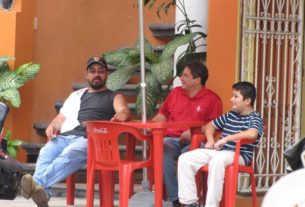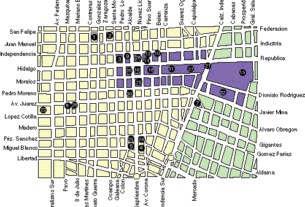The graceful 18th century Parroquia de San Andrés, is not only Ajijic’s chief landmark, but also the hub around which village life revolves. It is the focal point for those important milestones that bind the close-knit Mexican family: baptisms, first communions, confirmations, weddings and funerals. Poised in its multi-tiered campanario are the four bells that mark the pueblo’s daily rhythms, pealing in familiar language to call the faithful: las llamadas–three calls at 15 minutes intervals–before Mass; jubilant repicadas for special festivities; mournful clamores that spread the news when someone in the village dies.
In the sun-dappled patio next to the church, a tiny tile-roofed house lies tucked behind a tidy flower bed. Opposite it, an austere office with a single desk and a few mismatched chairs. These are the quarters where parishioners seek guidance and counsel from curate Refugio Mercado, the man who keeps so much activity in seamless motion.
Affectionately known to all as Padre Cuco, the stout and affable Señor Cura has managed to meet the daunting challenges of ministering to a rather unique community. In a place where deep-rooted traditions are still held dear, its native inhabitants are faced with a multitude of modern dilemmas, some brought on by a rapidly changing Mexican society, others linked to the influence of its ever-growing foreign population. The padre deftly guides his flock through such unfamiliar and often rocky terrain, tapping on an innate understanding of human nature.
Never wavering from rigid church doctrine, Padre Cuco’s wisdom, gentle demeanor, and uncomplicated approach to preaching the Catholic faith have earned him universal admiration and affection. Celebrations of the Mass are so streamlined, his homilies so brief and to the point, it’s easy for the congregation to stay focused on the message. Church-going is never a tedious ordeal–even for young children. They know that it won’t be long before they’ll be free to romp on the plaza, perhaps rewarded with an ice cream for their good behavior.
As my family and I settled into a pew for 12 o’clock Mass a few Sundays back we were surprised to learn we would be witnessing a double wedding. In addition, the two grooms, brothers it turned out, would be making their first communions. Immediately grasping the implications, my always restless ten year old flashed me a look of utter despair. “Don’t worry,” I whispered, “Padre Cuco is officiating.”
Sure enough, with his usual brevity the curate whizzed through the service. In less than an hour we were back out in the sunshine, watching the newlyweds dodge showers of rice. Another priest could easily have taken twice as long, perhaps taking time to admonish the brother-grooms whose ages belied a certain laxity in regard to their faith. From Padre Cuco they heard only a warm, if succinct welcome to the Church and its sacraments.
Our curate is not a man to preach fire and brimstone or scold parishioners for their failings and sins. Faith, love, acceptance, forgiveness are invariably the themes at the heart of his teachings. This is not to say he doesn’t exhort worshippers to preserve traditional values. In celebrating a festive December 12 Mass in honor of Mexico’s patroness, La Virgen de Guadalupe, he found an opportune moment to remind women to look towards the Savior’s mother as their role model. First and foremost, the responsibility of every mother is to oversee the well-being of spouse and children, he stated unequivocally. She is the family’s anchor, depended upon to maintain harmony in the home. At the tail-end of the 20th century, this is a stern and surprisingly un-modern message.
I have gone to Padre Cuco on occasion in researching some of the many local fiestas. Always generous with his time, he has proved immensely helpful, but he never fails to remind me that devotion is the common thread running through all these colorful celebrations.
Now and again I have observed him officiate at the 9 a.m. Sunday Mass for English-speakers. It’s an extraordinary experience. In careful, measured speech he sounds out the rites in a tongue that is clearly unfamiliar. The congregation’s part of the bargain is to join in singing traditional Mexican hymns. As a result, growing numbers of gringo parishioners now turn up and act at ease when Mass is celebrated in Spanish.
Hoards of foreigners–including many of other faiths–pay a visit to the parroquia on December 24 to view the enchanting living nativity scenes set up in the atrium. As they file past the church’s old wooden doors, Padre Cuco is there to wish a “meri chreestmus” to one and all. I would not venture to guess Padre Cuco’s inner thoughts about having so many strangers in his midst. It is clear, however, that he has made an effort to adapt to the needs of a multi-cultural community, effectively acting as a catalyst for integration as well.
Several days before my daughter was to celebrate her first communion we were instructed to see the Señor Cura for a family interview. We dutifully reported to Patricia, the parish secretary. “Oh yes, you’ve come to schedule the exam?” she inquired cheerfully. “The Padre will receive you at 8 o’clock.”
“Muy bien,” we replied, gulping. Clueless as to what the test would entail, we beat a hasty retreat. We had all of two hours to refresh our memories and cram on the commandments, the sacraments, the creed and other essentials of the faith. We were soon gathered around the padre’s desk, perched nervously on the edges of our chairs to face “the inquisition.” Directing his first question to our daughter Andrea, he asked, ” ¿Quién es tu patrón?“–Who is your patron (saint)? Her panic-stricken face told us all she needed help. Subtly tilting his head in the direction of the church behind him, Padre Cuco provided the needed hint. “¿San Andrés?” she answered uncertainly.
The priest nodded, smiling serenely. “Muy bien, hija.” We began to relax. Winging it as best we could, we went on to answer additional questions, questions that turned more on our responsibilities as Christians and members of a family than on rote memory of the catechism. Far from subjecting us to harsh examination, the padre was posing themes that merited reflection. Ten minutes later he was ready to send us on our way. “It looks like rain,” he said. “I best not keep you.”
He ended with what we later gleaned to be the main purpose of the interview: a brief lesson on how to keep our priorities straight. “Always remember,” he said, “First God, then family, then work. . . and then everything else.”
These are manageable tenets for anyone to live by, and very much in tune with what has been a way of life for generations of Axixiqueños. Ever so gently, Padre Cuco was shepherding us into the fold.


